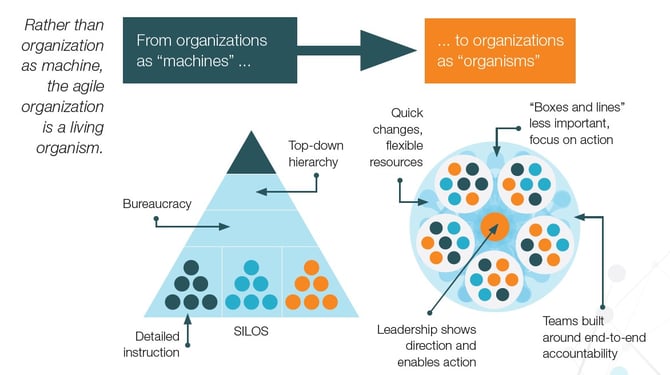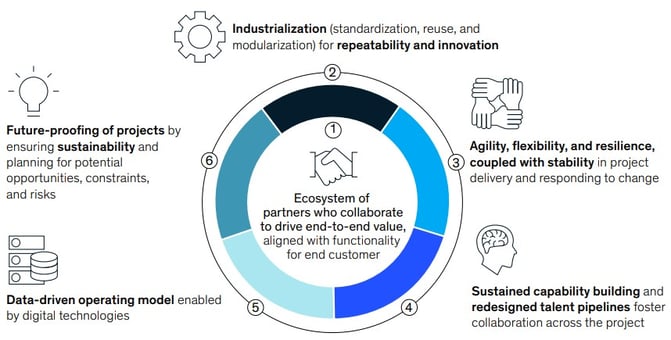In economic and sociopolitical times as demanding as those facing the world today, from the increase in material costs to international labor shortages and supply chain difficulties brought by the global health crisis and political instability, operational business excellence has never been more pivotal.
Transparency is the new visibility when it comes to capital construction project developments. For decades, organizations have struggled to capture accurate, reliable project performance, cost and schedule data. However, in recent years, there has been a growing emphasis on bringing visibility to these processes across all organizational functions.
“What will a top 20 percent Innovative leader look like in 5 or 10 years’ time?
We believe that these organizations will be highly agile and thrive in an environment of continual disruption. Current leaders who have invested in technology and innovation are already developing the skills and operating model to succeed”.
KPMG; Leaders and followers in the engineering & construction industry, Global Construction Survey, 2019
Since an operating model is a foundation of how organizations function and work on a day-to-day basis. Adopting agile operating principles and practices such as lean thinking, Design Thinking, and Agile is becoming increasingly familiar in capital project communities. These operating principles drive project delivery efficiency by streamlining communication across departments and teams, empowering individuals with accelerated decision-making capabilities, promoting cross-functional collaboration, and integrating standardized processes across an organization.

Operating Model and Organization Design
As a result, construction operations must be agile to maintain effectiveness in today’s fast-paced world. So, let’s take a closer look at what an Agile operating model means for construction firms and how it can help them thrive in today’s business climate.
Understanding the agile operating model
The agile operating model is a work philosophy for digital project management that was first created in the sphere of software development in 2001 – through the inauspicious yet groundbreaking publication of the Agile Manifesto.
The agile operating model is a framework for integrating agility into a business. It enables organizations to respond quickly and efficiently to shifting business conditions. Business agility can be applied and customized in all business activities, such as product management, marketing, sales, operations, and supply chain. The most successful companies are those that can quickly adapt to market changes, recognize new opportunities and respond with speed and agility. Business agility is about organizational culture, work design, continuous improvement and having the right people on board.
“Companies know that rigid, slow-moving models no longer cut it. The challenge is to move toward a structure that is agile, flexible, and increasingly collaborative while keeping the rest of the business running smoothly. Successful incumbents become agile by simplifying. They let structure follow strategy and align the organization around their customer objectives with a focus on fast, project-based structures owned by working groups comprising different sets of expertise, from research to marketing to finance”.
McKinsey Digital; Six building blocks for creating a high-performing digital enterprise, 2015
These same intrinsic operational values make the agile operating model an excellent means of adaptive management in the construction industry. Many of its principles, practices and tools synergize well with construction companies’ operational needs, including:
01. Ease of collaboration
An agile operating model helps companies collaborate across all functions and departments. Collaboration is more effective with common principles, vocabulary, and practices and teams work smarter, leveraging seamless communication channels and virtual co-location technology. This is one of the most critical aspects of successful Agile implementation.
02. Common understanding of value stream
Projects are often siloed within organizations, which can create many inefficiencies. Adopting agile operating principles can help break down these silos to create a shared understanding of the value stream. A value stream map helps an organization understand the flow of their projects, from customer requests through production and delivery. It can also help identify where gaps in functionality exist, where there are areas for improvement, and where any bottlenecks exist.
03. Ensure end-to-end transparency
Transparency extends beyond requirements into the entire lifecycle of a project. Each process phase should be transparent, including the backlog, status, estimated effort, and duration. Transparency into the status of a project allows stakeholders to make decisions about future projects or take corrective action on the project they are managing.
04. Risk is managed proactively
A truly agile organization proactively manages risk and uncertainty with a transparent operating model that enables project leaders and stakeholders to identify potential issues as they arise, making informed decisions to mitigate these risks. In addition, team members feel empowered to ask questions and identify problems as they arise, fostering collaboration and helping stakeholders understand their challenges and constraints.
05. Culture of continuous improvement
For decades, organizations have struggled to grasp the total cost of capital projects fully. Agile culture of continuous improvement drives investment in tools that help capture project data and drive greater transparency and accuracy. Organizations can employ agile project management tools in capital project environments to track schedule progress, resource utilization, project spend, risk and issues.
06. Greater resilience to the unexpected
The agile operating model promotes a greater resilience to unexpected events. The waterfall approach is sequential, while the agile process is iterative. In the waterfall approach, all activities are completed in one go, while in the agile methodology, they are broken down into smaller chunks. This allows greater flexibility, as organizations can pause and re-evaluate certain aspects of a project if specific criteria are not met.
Agile operating model key requirements

The key to implementing an agile operating model is to focus on customer value. Any business should be able to clearly identify their customer and their needs, then translate those needs into tangible and measurable outcomes. And since customers’ needs and expectations are constantly changing, successful businesses need to be flexible enough to adapt to those changes quickly. To achieve these goals, construction companies should focus on these four key areas of the agile operating model: culture, leadership, collaboration, and decision-making:
- Culture: Construction companies need to emphasize cultural change in order to compete effectively. They should create cultures that embrace collaboration, openness, and long-term value creation. Of course, it is easier said than done, but cultural change is a priority because it helps businesses to adopt agile implementation, which can be an obstacle if not prioritized.
- Leadership: Construction companies are notorious for their hierarchical cultures and top-down decision-making, which are incompatible with the agile operating model. Successful agile implementation requires a business to emphasize self-organizing teams, enable them to make decisions independently, and focus on delivering value to customers.
- Collaboration: Construction companies must embrace a more collaborative, open culture to implement an agile operating model. This means making decisions more inclusive and less hierarchical, creating and maintaining solid partnerships with all stakeholders, and delivering customer value efficiently.
- Decision-making: Construction companies need to embrace more inclusive decision-making approaches to understand their customers better and translate their needs into tangible outcomes. Decisions must be made at lower levels, and the decision-making process must be open and accessible to all stakeholders.
The interplay of traditional construction working best practices and the agile operating model
There can be no doubt that the traditional operating model of construction companies has manifold advantages. Indeed, the vast urban sprawls and high rises of the world’s great cities are themselves testaments to how effective the construction sector is in shepherding the very fabric of civilization ever forwards.
Construction has always been a challenging industry. However, the pace of change and need for innovation is accelerating faster than ever, thanks to the massive transformation of digital fabrication and automation, new operating models, and changing preferences of customers who now demand transparency and sustainability in their investments.
The interplay of traditional construction best practices and the agile operating model depends on the level of digitization within a specific industry. The agile operating model could be applied almost as-is if a sector is highly digitized and automated. At the same time, it’s important to recognize that not all practices apply in every situation. The agile methodology works well in some scenarios but might not be an optimal fit for others. Some methods, such as traditional waterfall and agile planning methodologies, are best used together for maximum positive impact on projects.
Not only does this imply a more streamlined integration of agile operational methods when undergoing a digital transformation, but it also serves to remind construction industry professionals that the agile operating model can proactively shore up weaker links in the value chain just as readily.
How does the agile operating model align with the traditional construction business model?
Agile and traditional construction business models can overlap across several dimensions. Let’s review a few of the most common ways in which Agile and traditional construction business models align:
- Cost: Traditional business models try to forecast and manage costs. agile business models use data to inform decision-making.
- Scope: Traditional business models rely on contractual obligations and careful scoping to deliver on projects. Agile business models focus on collaboration and responsiveness to change.
- Deliverables: Traditional business models focus on the contractual obligations of each side. Agile business models focus on collaboration and delivering value to customers.
- Resources: Traditional business models rely on planning and forecasting. Agile business models focus on using data to inform decisions.
How does the agile operating model differ from the traditional construction business model?

Source: McKinsey; The 5 Trademarks of Agile Organizations
The agile operating model is more future-focused, and the traditional operating model is more past-focused. The agile operating model focuses on continuous improvement, collaboration across the business, and quick decision-making based on data. The traditional operating model focuses on planning and control that are more slow, methodical, and based on estimates and forecasts. Regarding working with customers, the agile operating model focuses on collaboration and responsiveness. The traditional operating model has more of a contractual focus where the customer and contractor are both responsible for meeting their obligations.
How the agile operating model aligns with traditional leadership
The agile operating model emphasizes adaptive leadership practices. These include coaching, mentoring, and leading through influence. In contrast, traditional leadership practices are more about directing and commanding. While the agile operating model emphasizes these adaptive leadership practices, it does not suggest that traditional leadership practices are irrelevant.
The agile operating model also emphasizes the importance of empowerment in the construction industry. This is why Construction enterprises must adopt inclusive decision-making approaches and empower their employees to make the right decisions to adapt to the agile operating model.
Leadership styles such as situational and transformational leadership are still important in construction companies and are beneficial when driving operational excellence. However, being agile in construction does not mean tossing out formal leadership styles. Instead, it means finding a balance between traditional and agile leadership.
Agile construction companies evolve the efficiency of project development

Revenue growth is a top priority for every construction business, and Agile construction companies evolve the efficiency of project development by measuring and improving every stage of the process. This includes monitoring project risk, resource capacity, and portfolio management. Projects are monitored and controlled consistently. Projects are managed and monitored through collaboration, regular review meetings, and project dashboards. Projects are executed and managed with a hands-on approach. Projects are organized using a coherent methodology. Many of the best practices associated with the agile operating model are new to the construction industry. This includes:
- Agile contracting: Agile contracting is a form of commercial contracting that uses standard forms tailored to the needs of specific industries. The contract is agreed upon at the start of the project and rectified as needed throughout the project life.
- Agile procurement: Procurement is a process for identifying, evaluating, and selecting suitable materials or services for the project. It begins when the project is first conceived and continues throughout the project’s life, involving the people responsible for project decisions throughout the organization.
- Agile risk management: Risk is any event that could negatively affect a project’s expected outcome. Agile risk management ensures that all relevant stakeholders are involved in risk identification, assessment, and mitigation.
Moreover, in an era in which the labor shortage of countless industries, construction included, is a major point of debate worldwide, the cross-generational appeal of the agile operating model is a significant advantage if effectively actioned in construction management process improvement. Similarly, those construction sector laborers and white-collar workers with many years of experience can use the strategies empowering agile construction companies to leverage their expertise more effectively, drastically improving job satisfaction.
How Agile construction companies communicate and collaborate better
Communication is one of the most critical elements of the agile operating model, as it’s essential for project collaboration. Unfortunately, it’s also the area where many construction businesses struggle the most. Communication challenges within construction projects typically occur due to siloed teams that lack a single source of truth or a shared understanding of the project’s goals. Moreover, communication can be complex in a multi-site or multi-national project environment. The following strategies should be implemented to improve communication and collaboration within your organization:
- Practice Agile communication: Agile communication techniques prioritize closer collaboration and information sharing among stakeholders to ensure alignment and allow quick decisions and alterations throughout the process. It reduces the steps required to get the information across and includes a minimalist approach to documentation.
- Use visual management: Visual management involves creating visual representations of project plans and ensuring everyone involved have access to these visuals. This can be achieved by integrating Kanban boards where Agile construction teams can visualize their work process’s stages (and substages).
- Create a knowledge management system: A knowledge management system is a centralized tool that enables employees to find the information they need quickly, no matter where they are.
- Create the right culture: The right culture can support a “build relationships” strategy that helps you identify and connect with people with the necessary skills. It would be best if you also encouraged your team members to be more open and transparent, making collaborating easier.
Thanks to this enhanced level of collaboration, the day-to-day workflow in agile construction companies are much more efficient, and opportunities for idea generation, innovation and a level of empathy and understanding as to what makes each team tick are also enhanced.
The benefits of harmonizing the agile operating model with Modern Methods of Construction (MMC)

Source: McKinsey; Six fundamental changes underpin a new approach to capital project delivery
A construction company can benefit from implementing Modern Methods of Construction (MMC) and harmonizing them with an agile operating model. Your project teams can make better decisions thanks to the correct information and data availability. This can help you to avoid delays and cost overruns. MMC is a collection of methods and practices used to deliver projects. A construction company can benefit from implementing MMC principles such as integrated planning, demand management, automation, and Design for Manufacturing and Assembly (DfMA). These principles are designed to make projects more efficient, straightforward, and safer. When you combine these principles with an agile operating model, you can expect to see the following benefits:
- Better productivity: You can produce accurate estimates that reflect the project’s current state. This will reduce the risk of delays and cost overruns.
- Less risk: You can identify and manage risk earlier in the process. This will help you to avoid unnecessary costs.
- Reduced project complexity: You can build more uncomplicated, integrated plans that don’t require excessive resources. This will help you save money.
Since MMC minimizes downtime, waste of materials, and unnecessary workforce, Agile construction companies may use their new skills in analyzing and evaluating MMC practices to improve their scheduling efficiency as they implement MMC strategies in new developments.
Why construction businesses should adopt Agile
“A new operating model combines cloud-based digital technologies and agile operational capabilities in an integrated, well-sequenced approach that can rapidly accelerate digital strategy and transformation. The model helps to coordinate end-to-end operations across silos—supporting customer and employee journeys, for instance—while taking technology out of quarantine and making the most of it across all lines of business”.
McKinsey; Five priorities for CEOs in the next normal, September 2021
There are plenty of reasons why construction companies should adopt an agile operating model. The most important of these is that they allow quick and nimble decision-making in a constantly changing business environment. This is particularly important in the construction industry, where project timelines are notoriously hard to predict, and change is pervasive. When construction projects are delayed due to external factors, agility allows businesses to respond quickly. They can scale down or even cancel specific projects without worrying about their core operations grinding to a halt. This is crucial, given that many construction companies have struggled to keep up with the pace of change in recent years. If a company follows a rigid operating model, they risk being unable to respond to significant disruptions in its environment. This will almost certainly lead to substantial reductions in profitability and growth.
The digital transformation of the construction industry makes the agile operating model essential
A recent article by McKinsey, “Voices on Infrastructure: The project of the future,” highlights the need for construction companies to implement an agile operating model to support their digital transformation. That’s because the Agile model is designed to optimize the flow of information between stakeholders. It does this by reducing the number of steps involved in a particular process, meaning that your project teams can improve collaboration and decision-making thanks to the correct information and data availability. This can help you to avoid delays and cost overruns.
Bashar, the founder of the Construct360 system, can help orchestrate your company’s digital transformation and implementation of a modern operating model, explaining which agile strategies should work best for you. Agility and MMC are blurring the lines between manufacturing and construction. Are you and your team up for the challenge?
The agile operating model is one of the change catalysts and enablers in the Construct360 practical approach to digital transformation in construction and real estate development companies.
